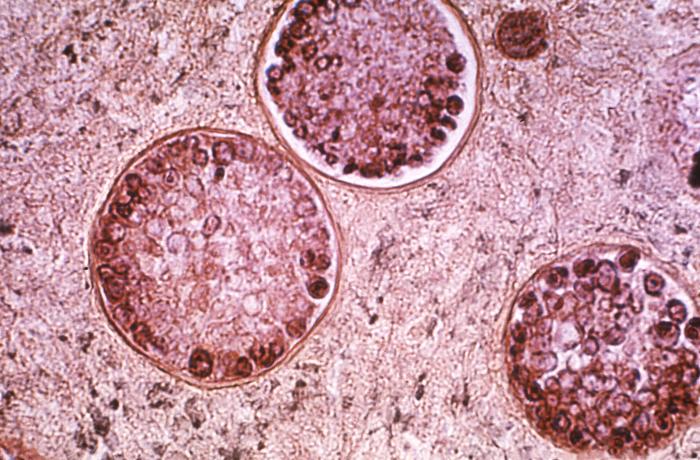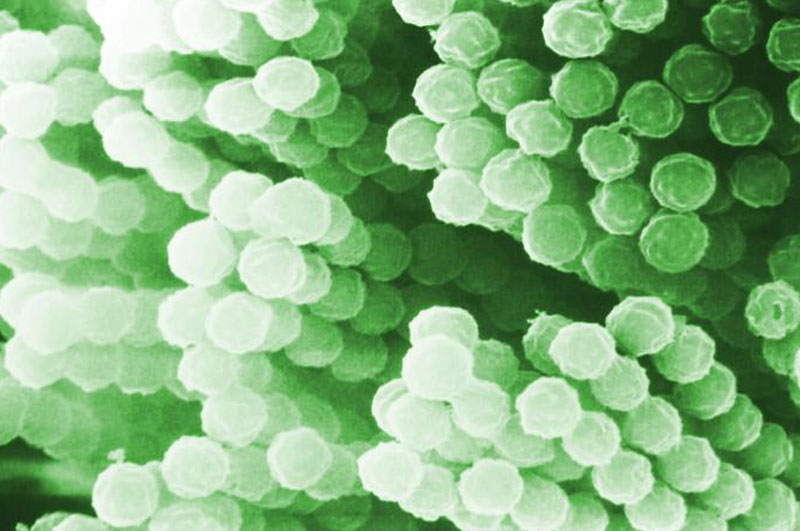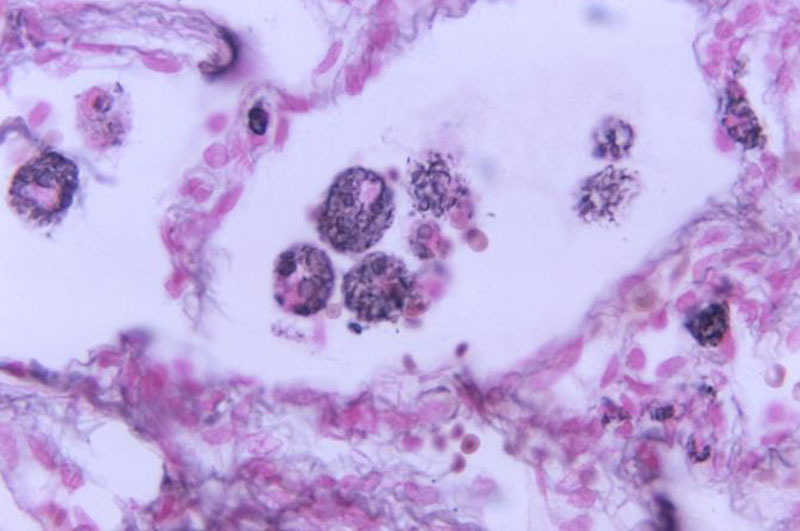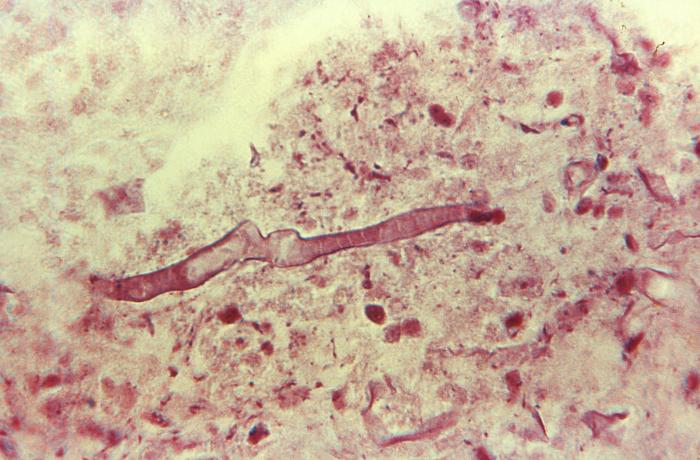Fungi
Fungi are everywhere. They live in the soil, on plants and trees, and they float in the air. Fungi play an important role in almost all ecosystems. They are premier decomposers. Fungi feed on organic matter produced by other organisms and absorb nutrients after secreting the enzymes needed to break them down into digestible bits. Without the fungi, we would have few efficient methods to break down dead and decaying matter into compounds which can be recycled and used by other organisms.
Athlete’s foot is caused by a fungus.
Image source: Wikipedia
Fungi live indoors on all types of surfaces and on human skin. Although tens of thousands of species of fungi exist, only about 300 are pathogenic (disease-causing).
Some fungal diseases are not serious health conditions and are treated easily; athlete’s foot is a common fungal disease that does not produce life-threatening consequences. Other fungal infections are potentially fatal and difficult to treat.
As you find out about the pathogenic fungi, it is important to remember that each group of fungi has both helpful and harmful species. We use fungi for food sources and food processing, they play important roles in almost every ecosystem, and symbiotic relationships with plants allow for better nutrient and water uptake and are used in manufacturing processes and bioremediation. They also produce deadly toxins, are now cultivated for illicit drug trade, and cause infectious disease. This lesson focuses on human infectious disease caused by fungi.
Objectives
To understand the importance of fungi in infectious disease, you should be able to:
- Be able to identify key fungal structures and their functions.
- Describe how fungi are classified.
- Describe examples of fungal diseases.
- Explain the importance of fungi in causing human infectious disease.
Vocabulary
- asci–spore-forming structure in the sac fungi (ascomycetes).
- basidium–spore-forming structure in the club fungi (basiomycetes).
- fungi–single or multi-celled, eukaryotic organisms that digest their food externally and absorb the nutrients into its cells; they do not undergo photosynthesis.
- heterotroph–an organism that is unable to synthesize its own organic compounds; it gets nutrients from feeding on other heterotrophs, autotrophs, or organic wastes.
- hyphae–filaments that make up the mycelium that contain chitin in their walls.
- mycelium–a mesh of branching filaments in fungi that absorbs food.
- mycology–the study of fungi.
- parasite–an organism that lives or in a host species; the parasites benefits, the host does not.
- saprob–a heterotroph that obtains organic compounds from nonliving organic matter; causes decay.
- spore–reproductive structure of fungi.
Pathogenic Fungi
Fungi are single or multi-celled, eukaryotic organisms that digest their food externally by secreting digestive enzymes and absorbing nutrients directly into their cells. They are non-motile and do not undergo photosynthesis.
Fungi are heterotrophs; they use nutrients other organisms have synthesized. Most are saprobes, obtaining their nutrients from nonliving organic matter. Some are parasites, living on or in another living organism and getting nutrients from that organism.
Multicellular fungi are made up of networks of tubes called hyphae which form dense structures called mycelium. The mycelium grows on whatever organism the fungus is growing. The obvious, above-ground structure is often only a small part of the entire fungus.
Fungi are classified into four groups based on the way they reproduce sexually by producing non-motile spores.
1. Sac Fungi
Sac fungi produce spores in cup-shaped sacs, called asci which contain 4-8 ascospores. This is the largest group of fungi.
Ascomycetes are important plant and animal pathogens and are also important in the production of some antibiotics.
Examples of human disease caused by fungi in this group are:
Coccidiomycosis

Slide of Coccidioides immitis.
Content: CDC/Dr. Lucille Georg
Image source: phil.cdc.gov
Also known as Valley Fever, coccidioidomycosis is an infection caused by Coccidioides, a fungus that lives in the dust and soil in Southwest U.S. and parts of Mexico and South America. The fungus was recently found in Washington. People become infected with Coccidioides by breathing in fungal spores in the air.
Most people exposed to the spores do not get sick. Some people who do get sick will recover on their own, but others will need anti-fungal medicines. Still others will develop chronic lung conditions. Symptoms include fever, coughing, shortness of breath, night sweats, headache, rashes, and muscle aches. The infection can spread outside the lungs and central nervous system, bone, and joint infections.
Aspergillosis

Scanning electron micrograph of chains of Aspergillus fungal spores.
Content: CDC/Robert Simmons
Image source: phil.cdc.gov
Aspergillosis is caused by a mold that lives in both inside and outside environments, including in the soil, on plants, in household dust and surfaces, and on food. Many people breathe in Aspergillus mold every day and do not get sick. People with compromised immune systems are at risk for infection.
Aspergillus infections range from mild to serious and also vary with where in the body the infection occurs. Infections can occur in the sinuses, in the lungs, in a combination of lungs and sinuses, and can invade other body parts. Symptoms range from coughing, headache and runny nose in mild cases to fever, chest pain, coughing up blood and weight loss in more severe cases.
2. Club Fungi
Club fungi produce spores in club-shaped structures, called basidia. Fungi that belong to this group cause disease in both plants (rusts and smuts) and animals, including humans. Examples of basidiomycetes that cause human disease include yeasts and Cryptococcus sp.

Stained slide of Cryptcoccus in a lung lesion tissue specimen.
Content Provider: CDC
Image source: phil.cdc.gov
Caused by infection with Cryptococcus neoformans, these infections can affect the lungs or the brain. In the lungs, C. neoformans cause pneumonia-like symptoms with coughing, shortness of breath, chest pain, and fever. In the brain, the infection causes headache, fever, neck pain, nausea and vomiting, and sensitivity to light. Anti-fungal medications must be taken for at least 6 months and sometimes longer. Cryptococcal infections are rare in people with healthy immune systems. It is, however, a major infection in HIV/AIDS patients.
3. Sporangia Fungi

Gram stain of a mycelium of Rhizopus sp.
Content: CDC/Dr. Lucille Georg
Image soruce: phil.cdc.gov
Sporangia fungi produce spores in round-shaped structures called sporangia. Diseases produced by this group are most commonly from a group of molds that are transmitted by inhalation, by needle puncture, or by ingestion. Most infections occur in immunocompromised people, those who undergo prolonged antibiotic or steroid therapy, or those having severe malnutrition.
4) “Imperfect fungi”
The “imperfect fungi” is a group of unrelated fungi that have no recognized sexual reproductive stage. It may be that these fungi have lost their sexual spore-producing phase through evolution or it may be that biologists have just not observed the phase in the appropriate environmental conditions.
Penicillium sp. is the best known fungus in this group. The antibiotic penicillin was first made from this species.
Check Your Understanding
- Differentiate members of the Kingdom Fungi from the members of each of the other kingdoms.
- How are the fungi classified? List the groups according to this classification and give an example of each.
- People are constantly exposed to fungi and their spores, yet fungal diseases are relatively rare in the general population. Why?
- Under what circumstances will an aerial borne fungus cause disease in humans?

